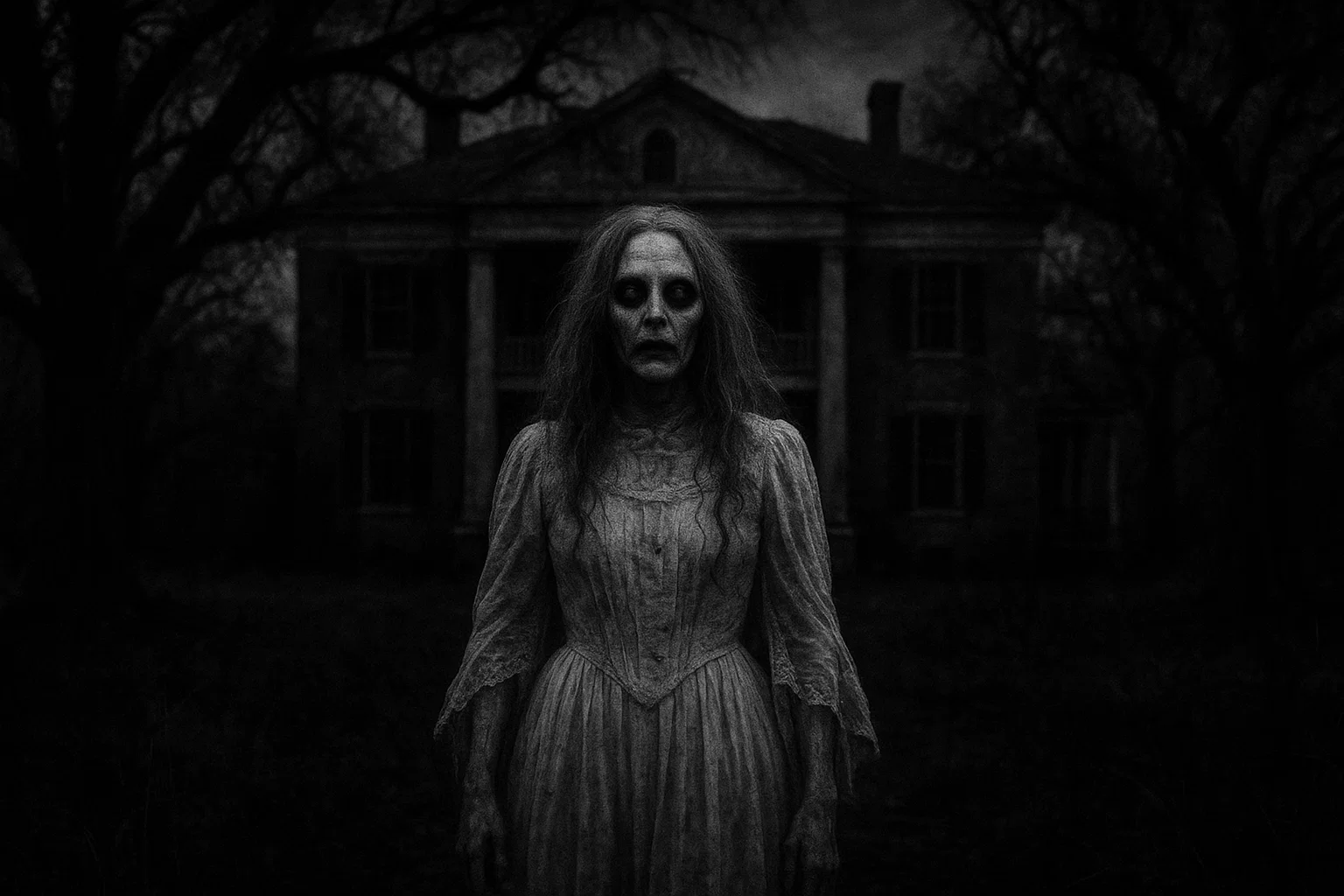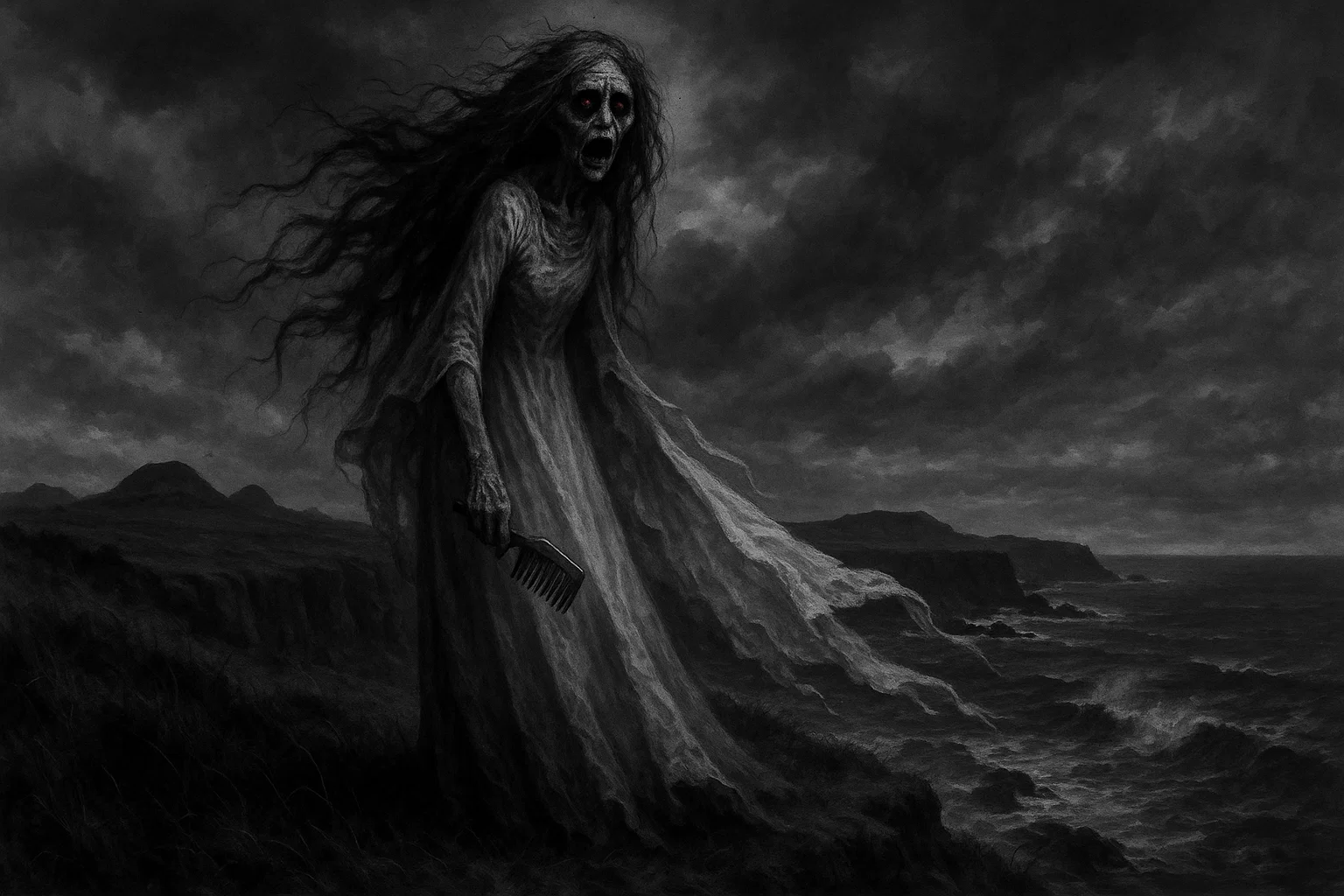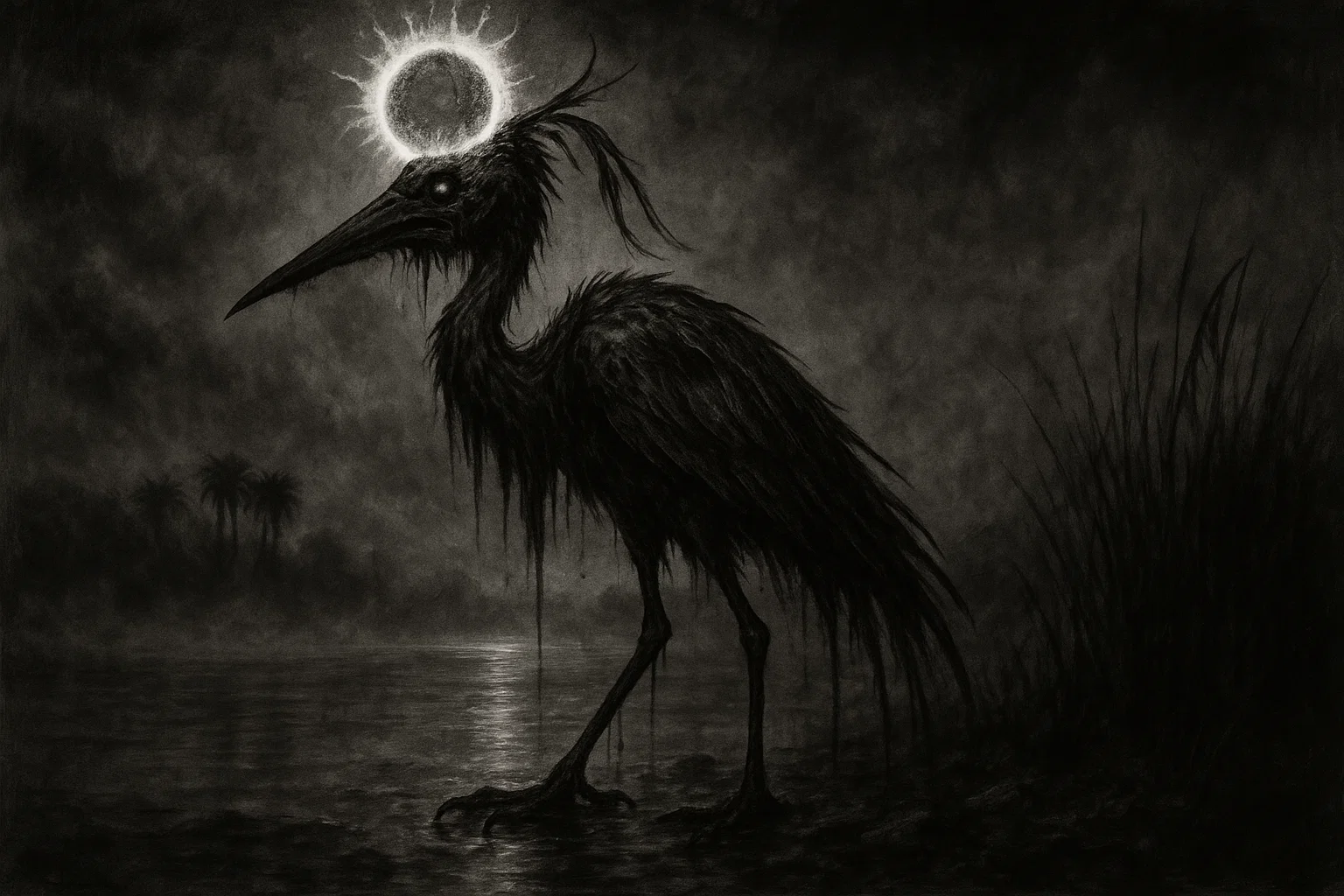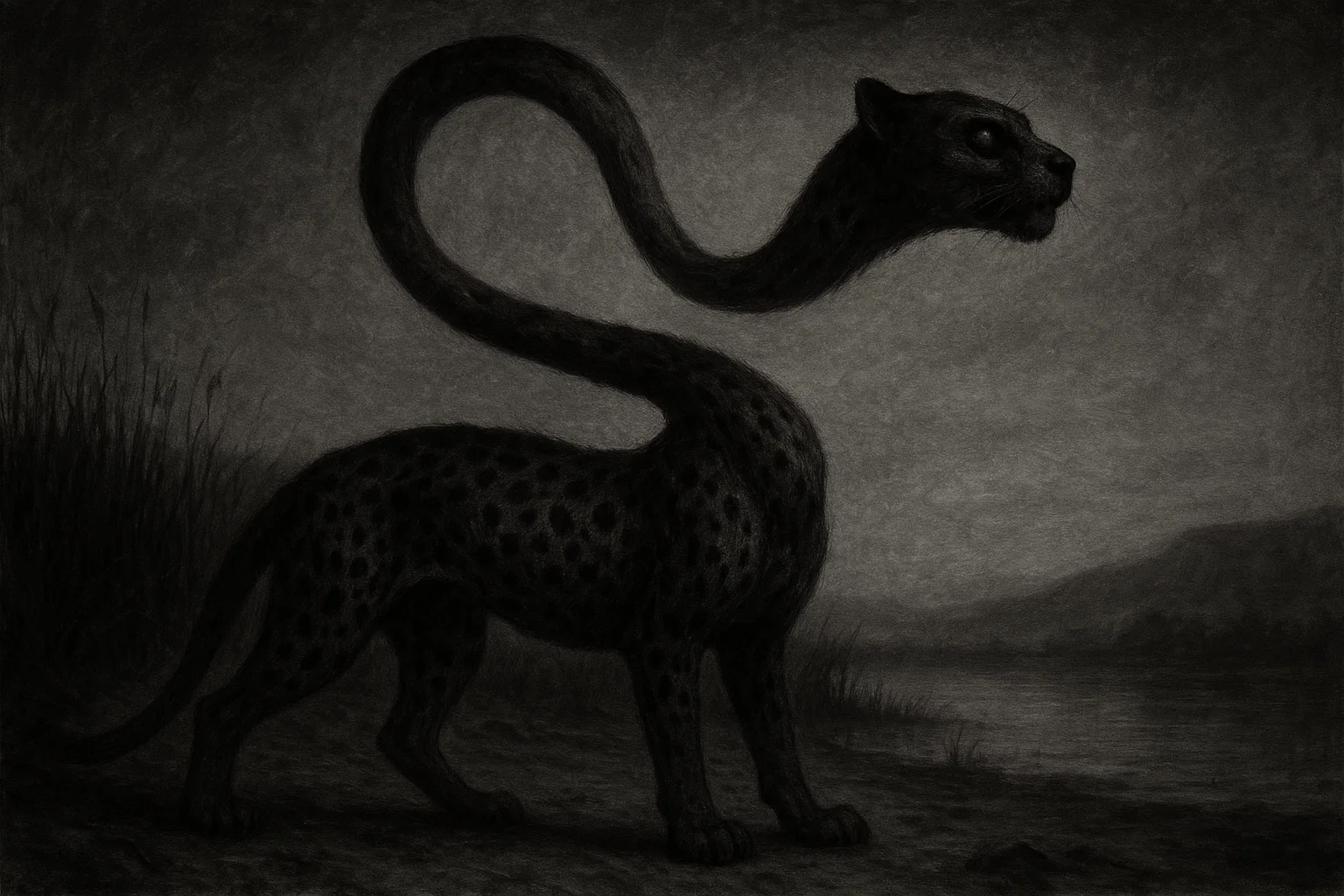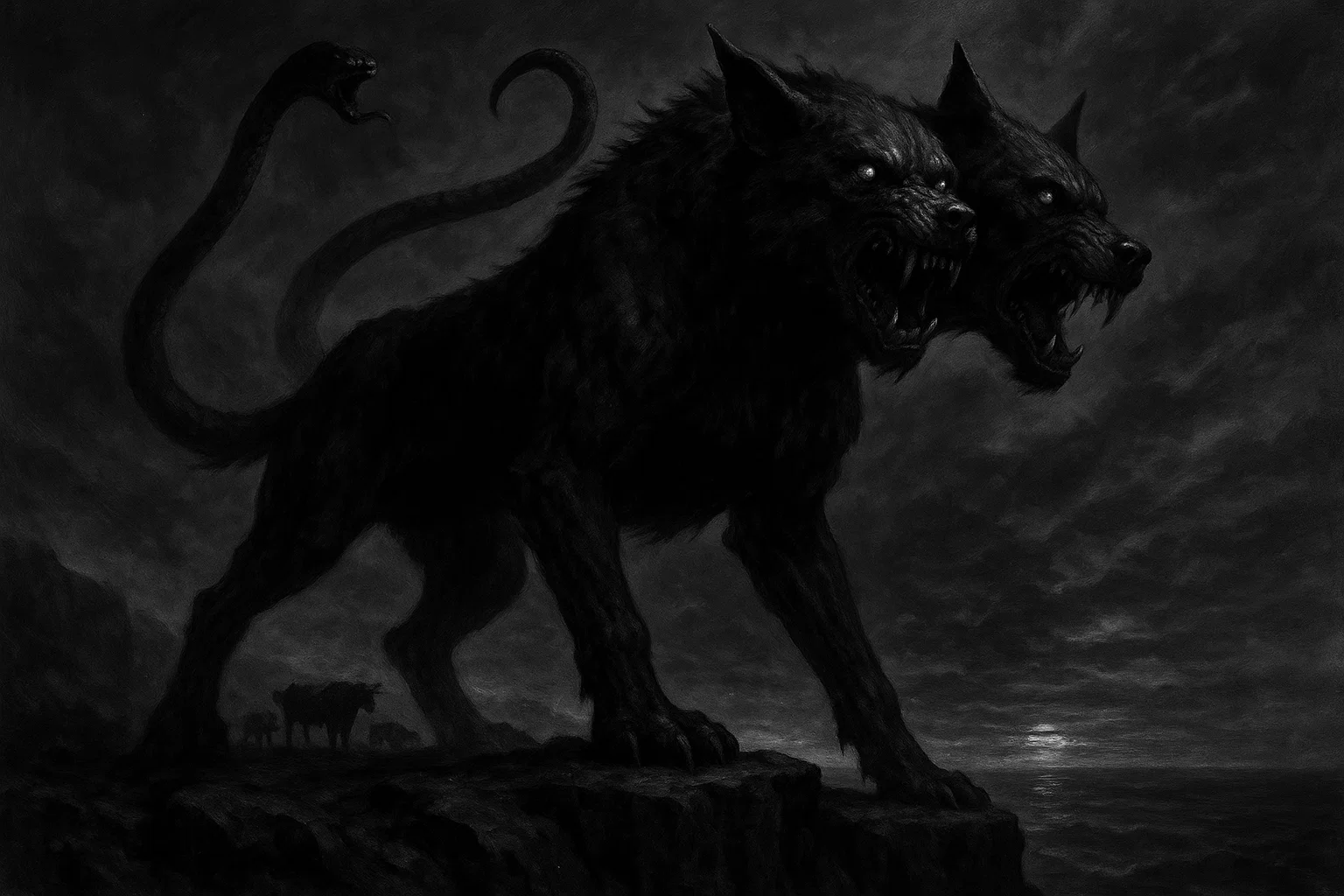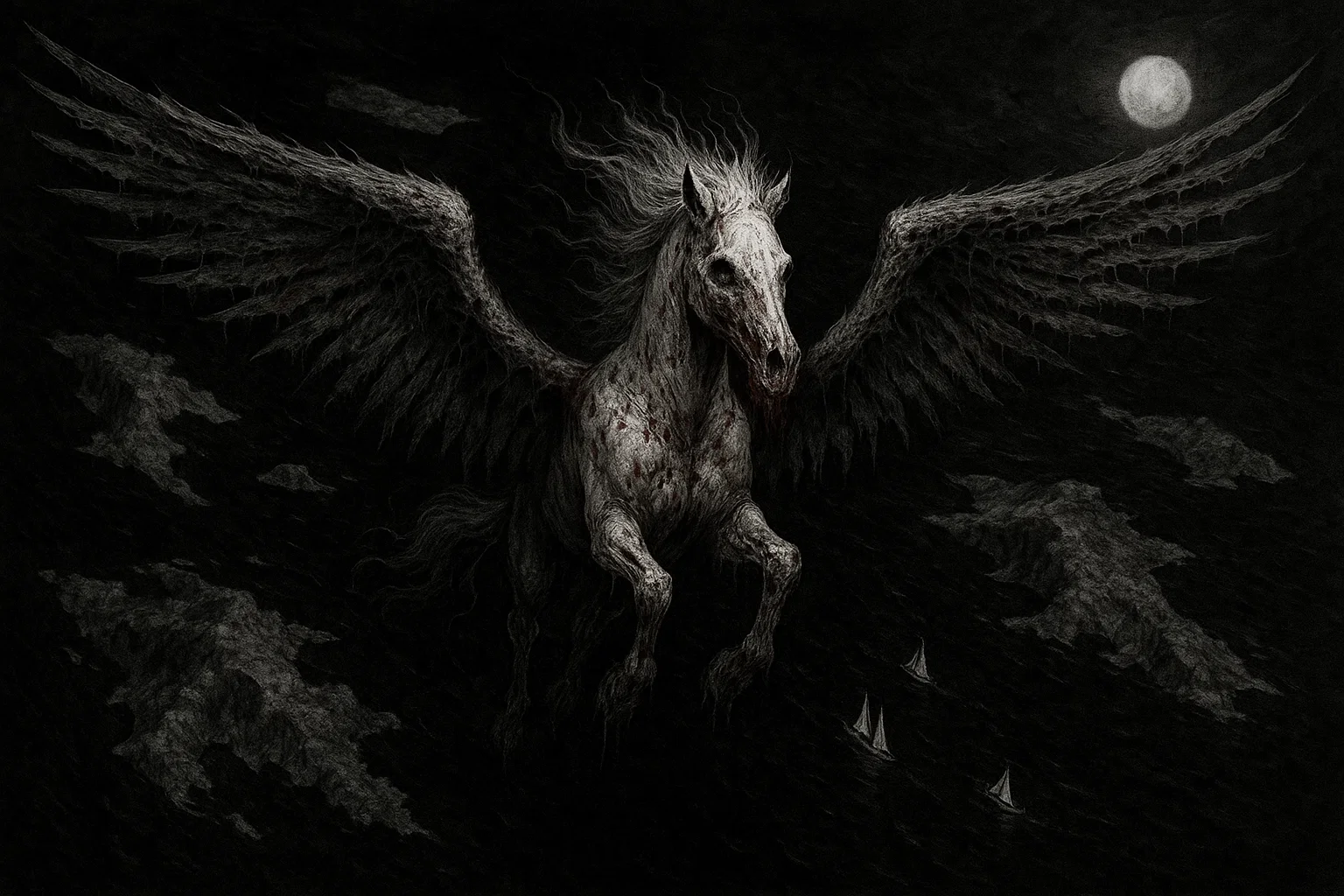Are you ready to uncover the chilling secrets of the Kali Oka Plantation haunting and Oak Grove Plantation haunting in Saraland, Alabama? Nestled along the eerie Kali Oka Road, these historic mansions hold tales of restless spirits and unexplained phenomena that have captivated paranormal enthusiasts for decades.
From shadowy figures to haunting cries, the Saraland haunting promises a journey into the unknown. What mysteries lurk within these walls, and what truths lie behind the ghostly legends? Dive into the spine-tingling history and supernatural allure of these Alabama landmarks.
Summary
Overview
The Kali Oka Plantation and Oak Grove Plantation in Saraland, Alabama, are renowned for their chilling hauntings, centered on the apparitions of a white woman, a seven-foot-tall black man, and a child linked to the nearby Cry Baby Bridge.
Despite their names, these properties are not traditional plantations but two mansions built in 1895 and 1900 by brothers Matthew Livingston Davis and Ben Davis for their sawmill operations in Mobile County.
Located near Kali Oka Road and Oak Grove Road, the sites have drawn paranormal enthusiasts due to reports of ghostly figures, tactile sensations, whispers, and cries.
Key facts about the Kali Oka Plantation haunting and Oak Grove Plantation haunting include:
- Location: Eight Mile, Saraland, Mobile County, near the Mobile & Ohio Railroad.
- Construction Dates: Kali Oka mansion was built in 1895, and Oak Grove in 1900.
- Primary Ghosts: A white woman (possibly a Davis family member), a tall black man (likely a sawmill worker or servant), and a child tied to Cry Baby Bridge folklore.
- Activity Types: Visual apparitions (woman lighting candles, man on grounds), tactile touches, auditory phenomena (whispers, baby’s cries).
- Historical Context: Mansions linked to the Davis brothers’ lumber empire, restored by June and Thomas Crowley for events.
- Cultural Impact: Featured in horror films Dead Birds (2004) and Hayride (2012), enhancing their haunted reputation.
- Controversy: Sparse historical records fuel speculation about the ghosts’ identities, with skeptics citing swamp gas or psychological priming as explanations.
Historical Background of Kali Oka and Oak Grove
The Setting: Saraland, Alabama
Saraland, a small city in Mobile County, Alabama, lies just north of Mobile, a historic port city known for its maritime and industrial heritage. The Kali Oka Plantation and Oak Grove Plantation are situated in the Eight Mile community, near the intersection of Kali Oka Road and Oak Grove Road.
This rural area, characterized by dense woods, swampy marshlands, and the infamous Dead Man’s Curve, was a key hub for the lumber industry in the late 19th century. The Mobile & Ohio Railroad, running parallel to Kali Oka Road, facilitated the transport of timber, making the region a vital economic center.
The proximity of Cry Baby Bridge, a small overpass spanning Kali Oka Creek, adds to the area’s eerie folklore, with its reputation for ghostly cries amplifying the haunting narrative.
Architectural and Historical Context
The Kali Oka and Oak Grove properties are not sprawling plantations but elegant mansions constructed by Matthew Livingston Davis and Ben Davis. Matthew, born around 1850, established a commercial sawmill in Eight Mile in the 1880s, capitalizing on Alabama’s rich pine forests.
His success led to the construction of the Kali Oka mansion in 1895, a two-story Greek Revival home featuring a gabled roof, symmetrical facade, full-width front porch with Doric columns, and intricate interior woodwork.
Ben, born circa 1855, built the Oak Grove mansion in 1900, a slightly smaller but similarly styled residence with a wraparound veranda and ornate detailing.
Together, the mansions and their 11 outbuildings—barns, servants’ quarters, and a smokehouse—form the Davis-Oak Grove District, spanning 12.2 acres and recognized on the National Register of Historic Places in 1988 for its architectural and economic significance.
You May Also Like: The Ivanov Directive | Horror Story
The sawmill, operational until the 1930s, employed dozens of workers, including African American laborers and domestic servants, some of whom lived on the property. After the sawmill’s closure, likely due to resource depletion or the Great Depression, the mansions fell into disrepair, suffering vandalism and neglect.
In the late 20th century, June and Thomas Crowley purchased and meticulously restored both homes, preserving their period charm with the aid of a professional decorator.
Today, the properties serve as venues for weddings, receptions, and corporate events, with their historical ambiance enhanced by their use in horror films Dead Birds (2004), filmed at Kali Oka, and Hayride (2012), which used Oak Grove’s exterior.
This cinematic legacy, combined with their haunted reputation, draws visitors seeking both history and the supernatural.
The Ghosts of Kali Oka and Oak Grove
The Kali Oka Plantation haunting and Oak Grove Plantation haunting revolve around three distinct spirits: a white woman, a seven-foot-tall black man, and a child associated with Cry Baby Bridge. Each ghost is tied to speculative but vivid narratives rooted in the properties’ history, though sparse records leave their identities open to debate.
The White Woman
The white woman is believed to be a member of the Davis family, possibly Elizabeth Davis, the wife of Matthew Livingston Davis, or another female relative.
Born around 1855, Elizabeth is mentioned in local lore as a refined, melancholic figure who lived in the Kali Oka mansion during its early years. She is described as wearing a flowing white gown, typical of late 19th-century fashion, and is often seen lighting candles in the upstairs windows of the main house.
Witnesses report her apparition exuding sorrow or longing, with some accounts suggesting she suffered a personal tragedy, such as the loss of a child or a forbidden love affair.
One narrative claims she was involved with a servant, possibly the tall black man, leading to a scandal that ended in violence. Her candle-lighting is interpreted as a ritual to guide lost souls or to mourn her fate, with her gentle touches and whispers (“Help me” or “He’s gone”) reflecting her emotional turmoil.
The Seven-Foot-Tall Black Man
The tall black man, described as a towering figure with a commanding presence, is a central enigma of the haunting.
Local stories offer conflicting accounts: some depict him as a slave or freedman who worked as a laborer or bodyguard for the Davis family, while others suggest he was a housekeeper or overseer at the sawmill.
His height, estimated at seven feet, and dark complexion point to an African American individual from the sawmill era, possibly born around 1860.
One tale claims he was Elijah, a trusted servant who protected Elizabeth Davis but was killed by a jealous husband or rival in the 1890s, perhaps by hanging or beating near Kali Oka Road.
His apparitions are reported on the grounds, along the road, or standing sentinel on the front porch, often accompanied by a protective or mournful aura.
Witnesses describe his shadow-like form vanishing into mist, with some hearing deep-voiced warnings like “Stay away” or “Leave now.” His presence suggests a spirit bound by duty or unresolved injustice.
The Child of Cry Baby Bridge
The child’s spirit, linked to Cry Baby Bridge, is said to be the offspring of the white woman, possibly Elizabeth, who drowned in Kali Oka Creek to conceal an illicit affair, likely with the tall black man.
This narrative, dating back to the early 20th century, aligns with regional “Cry Baby Bridge” folklore, where a mother’s desperate act leads to a haunting.
You May Also Like: Maple Hill Cemetery Haunting: Ghost Child Sightings and Eerie Legends
The child speculated to be an infant or toddler, is not visually seen but manifests through piercing cries heard at night near the bridge. Some accounts suggest the drowning occurred around 1898, during a period of social upheaval in Mobile County.
The cries, described as heart-wrenching and ethereal, evoke guilt or loss, tying the child’s spirit to the broader tragedy of the Davis household.
Nature of Paranormal Activity
The hauntings manifest through diverse phenomena, concentrated in the Kali Oka mansion, its grounds, and Cry Baby Bridge:
- Visual Apparitions: The white woman is seen lighting candles in upstairs windows or standing in doorways, while the tall black man appears on the grounds, porch, or Kali Oka Road, often vanishing into mist.
- Tactile Sensations: Gentle touches on the shoulder, back, or neck, attributed to the woman, are reported in the main house, particularly in the parlor and bedrooms.
- Auditory Phenomena: Whispers (“Help me,” “He’s gone,” “Stay away”), sighs, or deep male voices are heard in the house, with baby cries emanating from Cry Baby Bridge.
- Atmospheric Changes: Cold spots, sudden mists, or feelings of being watched occur in the main house and along the road, especially at dusk or midnight.
- Physical Disturbances: Before restoration, books fell from shelves, doors slammed, or curtains moved without cause, particularly in the Kali Oka mansion.
These activities suggest a combination of intelligent and residual hauntings, with the woman and man interacting purposefully, while the child’s cries replay a traumatic event. The phenomena’s intensity near Kali Oka Road and the bridge underscores the area’s haunted reputation.
Sightings and Testimonies of the Kali Oka and Oak Grove Haunting
The Kali Oka and Oak Grove properties have amassed numerous testimonies since the 1960s, when Kali Oka Road was a primary route due to Interstate 65’s construction, exposing travelers to the area’s eerie reputation.
Local historian Cassandra Malone, who has studied Mobile County’s folklore, notes the consistency of sightings across decades. Reports come from residents, event guests, film crews, and passersby, with Cry Baby Bridge adding a distinct layer of folklore.
Below is a comprehensive table of all known sightings, with specific dates where possible and direct quotes to capture the witnesses’ experiences:
| Date | Witness | Location | Description | Quote/Excerpt |
|---|---|---|---|---|
| 1965 | Sarah T., Local Resident | Kali Oka Road | Saw flickering lights and mist in the woods near the road at midnight. | “I saw lights dancing in the woods, like lanterns, but they faded into mist.” |
| 1972 | Michael R., Teenager | Main House | Heard books crash off shelves in the parlor while exploring the abandoned house. | “Books just flew off the shelf in the parlor; we ran out scared to death.” |
| 1983 | Emily W., Visitor | Kali Oka Mansion | Saw a woman in white lighting candles in an upstairs window at dusk. | “A woman in a white dress was lighting candles; she looked right at me.” |
| 1992 | Mobile County Paranormal Society | Main House | Recorded EVPs of a male voice saying “Stay away” and a female voice whispering “Help me.” | “We got ‘Stay away’ in a deep voice and ‘Help me’ from a woman on our recorder.” |
| 1997 | John P., Local Driver | Kali Oka Road | Saw a tall black man walking along the road, vanishing near Dead Man’s Curve. | “A huge man was walking by the road, then he just melted into the fog.” |
| 2004 | David L., Film Crew Member | Kali Oka Grounds | Felt a touch on his shoulder while setting up lights for Dead Birds. | “Something touched my shoulder on set; I turned, but no one was there.” |
| 2012 | Anna M., Wedding Guest | Oak Grove Porch | Saw a tall figure on the porch during a reception, gone when approached. | “A tall man stood on the porch, staring; he was gone when I got closer.” |
| 2016 | Laura K., Event Guest | Kali Oka Mansion | Felt a gentle touch on her back in the parlor; heard a whisper saying “He’s gone.” | “I felt a hand on my back, and a woman’s voice whispered ‘He’s gone’ in my ear.” |
| 2018 | Tom R., Driver | Cry Baby Bridge | Heard a baby’s cries while crossing the bridge at 1 a.m. | “A baby’s cry came from under the bridge; it was so clear, it broke my heart.” |
| 2020 | Rachel S., Photographer | Kali Oka Grounds | Captured a shadow in photos near the barn; felt a cold spot. | “My photos showed a dark figure by the barn, and I got so cold suddenly.” |
| 2022 | Mark D., Local Teen | Cry Baby Bridge | Heard cries and saw a faint mist forming over the creek at night. | “I heard a baby crying, and a weird mist came up from the creek.” |
Analysis of Testimonies
The sightings, spanning 1965 to 2022, highlight the enduring nature of the Kali Oka and Oak Grove hauntings.
The white woman’s candle-lighting and the tall man’s roadside appearances are the most consistent, suggesting intelligent spirits tied to the Davis family or their workers.
The child’s cries at Cry Baby Bridge, reported since the 1960s, align with regional folklore, evoking themes of maternal loss. Pre-restoration accounts (1970s) include physical disturbances like falling books, possibly due to the homes’ dilapidated state, while post-restoration reports focus on apparitions and tactile sensations, reflecting increased human activity.
The 2004 film crew testimony ties the haunting to the properties’ cinematic legacy, while recent sightings (2020–2022) indicate ongoing activity despite limited public access.
Paranormal Investigations
The Kali Oka and Oak Grove properties have been investigated by local groups, notably the Mobile County Paranormal Society, with efforts concentrated in the 1990s and early 2000s during the restoration phase.
These investigations, conducted with permission from the Crowley family, focused on the Kali Oka mansion and its grounds, with limited access to Oak Grove due to its smaller size.
You May Also Like: The House That Feeds | Horror Story
No major television shows have documented the sites, likely due to their private ownership and event-focused use, but local researchers have gathered compelling if anecdotal, evidence specific to these hauntings.
Detailed Findings
Electronic Voice Phenomena (EVP): In 1992, the Mobile County Paranormal Society recorded EVPs in the Kali Oka mansion’s parlor and upstairs bedrooms, capturing a male voice saying “Stay away” and a female voice whispering “Help me.” A 2001 session recorded a faint “He’s gone” in the same areas, aligning with the white woman’s narrative.
Photographic Evidence: Investigators captured orbs and shadows in the main house’s windows and on the front porch, particularly during dusk sessions in 1997. A 2003 photo showed a faint female silhouette in an upstairs window, though its clarity is debated.
Temperature Fluctuations: Sudden drops of 5–10°F were recorded in the parlor, upstairs hallway, and near the porch, correlating with sighting reports. A 1999 investigation noted a consistent cold spot in the southeast bedroom, linked to the white woman’s appearance.
Electromagnetic Field (EMF) Spikes: K-II meters detected spikes in the parlor and near the front porch, areas associated with the tall black man. These occurred without electrical interference, suggesting a localized energy source.
Motion Sensors: Infrared sensors triggered in unoccupied rooms, particularly the upstairs bedrooms, during a 2000 investigation, indicating movement consistent with reported apparitions.
These findings, while not peer-reviewed, are specific to the Kali Oka and Oak Grove hauntings, with EVPs and temperature anomalies aligning with witness accounts of the white woman and tall man.
Theories Explaining the Kali Oka and Oak Grove Haunting
Paranormal Theories
Forbidden Love and Murder: The leading theory posits that the white woman, possibly Elizabeth Davis, and the tall black man, perhaps Elijah, were lovers whose affair ended in his murder around 1898. A jealous husband or rival may have killed Elijah by hanging or beating near Kali Oka Road, with Elizabeth’s candle-lighting symbolizing her eternal search for him. The child’s drowning at Cry Baby Bridge could be their offspring, hidden to avoid scandal.
Protective Duty: The tall black man may have been a bodyguard or housekeeper tasked with protecting Elizabeth, killed while defending her from an external threat. His porch and roadside appearances suggest a duty-bound spirit, while her whispers reflect dependence on his protection.
Sawmill-Era Injustice: The sawmill’s labor-intensive environment, employing African American workers, may have led to unrecorded deaths or injustices. The tall man’s spirit could represent a collective trauma, with Elizabeth’s presence tied to domestic strife within the Davis household.
Cry Baby Bridge Tragedy: The child’s spirit may stem from a real drowning, possibly linked to Elizabeth’s personal loss. The cries, heard since the early 20th century, suggest a residual haunting tied to maternal guilt or societal pressure.
Rational Theories
Swamp Gas and Environmental Factors: The properties’ proximity to marshlands could produce methane gas, creating mists and lights mistaken for apparitions. Breezes from Kali Oka Creek might mimic touches or whispers, while the bridge’s acoustics amplify natural sounds into cries.
Psychological Priming: The properties’ use in horror films and their haunted reputation may prime visitors to interpret normal sensations as paranormal, especially during emotional events like weddings. Confirmation bias enhances these perceptions in the dimly lit mansions.
Historical Embellishment: Sparse records about the Davis family’s personal lives suggest that stories of love, murder, or drowning may be folkloric exaggerations, crafted to enhance the area’s mystique. The Cry Baby Bridge tale mirrors regional legends, possibly unrelated to the Davis family.
You May Also Like: The Edge of Nothing | Horror Story
Structural and Electrical Anomalies: The mansions’ aged wooden floors and drafty windows could produce creaks or air currents, while early 20th-century wiring might cause EMF spikes, inducing unease mistaken for ghostly presence.
These theories are tailored to the Kali Oka and Oak Grove hauntings, focusing on the Davis family’s history, the properties’ environmental context, and their role in Saraland’s folklore.
Comparison with Similar Hauntings
The Kali Oka and Oak Grove hauntings share traits with other U.S. hauntings involving intelligent spirits in historic residences.
| Haunted Place | Location | Ghost Name(s) | Type of Activity | Historical Context | Similarity to Kali Oka & Oak Grove |
|---|---|---|---|---|---|
| Lucas Tavern | Montgomery, AL | Eliza Lucas | Visual (waving figure), auditory | 1820 tavern, hostess’s death | Friendly spirit, historical figure |
| Drish House | Tuscaloosa, AL | Sarah Drish | Visual (phantom fires), auditory | 1837 plantation, owner’s death in 1884 | Tragedy-linked ghost, domestic setting |
| Gaineswood Plantation | Demopolis, AL | Evelyn Carter | Auditory (voices, singing), visual | 1843 plantation, nanny’s death | Named ghost, plantation setting |
| Sloss Furnaces | Birmingham, AL | James “Slag” Wormwood | Visual, tactile (pushing), auditory | 1880s industrial site, foreman’s death | Named male ghost, workplace tragedy |
| Lemp Mansion | St. Louis, MO | Lemp family | Visual, auditory, tactile | 19th-century mansion, family suicides | Family tragedy, intelligent haunting |
| Whaley House | San Diego, CA | Yankee Jim Robinson | Visual, auditory | 1857 home, executed criminal | Specific ghost, historical residence |
| Winchester Mystery House | San Jose, CA | Victims of Winchester rifles | Visual, auditory | 1884 mansion, ongoing construction | Multiple spirits, large historic home |
| Lizzie Borden House | Fall River, MA | Lizzie Borden, family | Visual, auditory, tactile | 1892 home, infamous murders | Specific figures, tactile phenomena |
| Carnton Mansion | Franklin, TN | Civil War soldiers | Visual, auditory | 1826 plantation, Civil War hospital | Historical tragedy, plantation setting |
| McRaven House | Vicksburg, MS | Civil War soldiers | Visual, auditory | 1797 home, Civil War hospital | War-related spirits, historical residence |
| Waverly Hills Sanatorium | Louisville, KY | Unnamed patients | Visual, auditory, tactile | 1910 sanatorium, tuberculosis deaths | Multiple spirits, institutional setting |
| Plantation House | Prattville, AL | Mr. Davis | Tactile (touches, breath), auditory, visual | 1832 home, owner’s suicide in 1925 | Intelligent haunting, specific ghost |
The Kali Oka and Oak Grove hauntings align with Drish House and Plantation House, where named or speculated individuals tied to tragic events drive the narrative.
The tactile and auditory phenomena, such as touches and whispers, mirror those at Lemp Mansion and Lizzie Borden House, suggesting intelligent spirits. The Cry Baby Bridge element parallels folklore in McRaven House, evoking themes of loss.
Unlike industrial or institutional hauntings (Sloss Furnaces, Waverly Hills), the domestic setting of Kali Oka and Oak Grove fosters a personal, less aggressive presence, akin to Lucas Tavern.
Conclusion
The Kali Oka Plantation and Oak Grove Plantation in Saraland, Alabama, weave a haunting tapestry of history and the supernatural. Built by the Davis brothers in 1895 and 1900, these mansions, restored by June and Thomas Crowley, are haunted by a white woman, a tall black man, and a child’s spirit tied to Cry Baby Bridge.
Vivid testimonies of apparitions, touches, and cries, coupled with local investigations capturing EVPs and anomalies, underscore their paranormal allure.
Whether driven by tragic love, duty, or environmental factors, the Kali Oka and Oak Grove hauntings remain a cornerstone of Alabama’s haunted heritage, inviting exploration by skeptics and believers alike.

